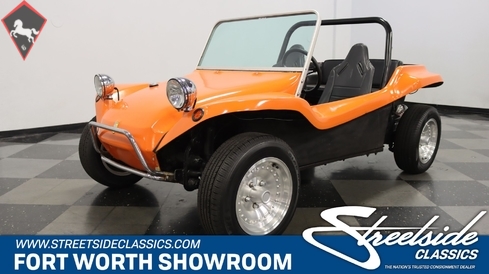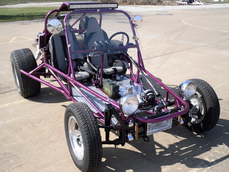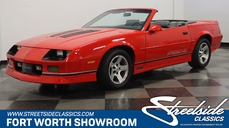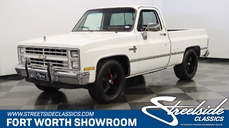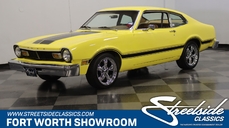Volkswagen Beach Buggy Buggy 1600 CC 1964
Allgemeine Beschreibung :
Description
This eye-catching 1964 Volkswagen Dune Buggy is a perfect example of when the automobile is distilled into 100% pure fun. Sure, it's actual transportation that can go from A to B, but the reason this car was built was to put a big grin on your face - and not much else. With a great-running 1600cc Flat 4, a quick-shifting 4-speed manual, and loads of style in its bright orange package, this little troublemaker is ready to tear up the beach and provide the next owner with loads of fond memories.
We can all but guarantee you'll be the only person tooling around in one of these, even though the look is instantly familiar to anyone that's ever been on a beach vacation. Unlike, say, the T-Bucket, this is not just some 2-seater that can only go in a straight line. No, this open-air beauty hauls four people and can handle itself in sand, mud, asphalt, and maybe even a little water if you keep the exhaust clear (think deep puddles or the ocean's shore for some killer rooster tails, not the bottom of a lake). There's not much to the lightweight fiberglass body, but what you get is pretty darn awesome – sharp front fenders, a squared-off deck in back, and an exposed bottom bucket and suspension - and the whole design is very professional and was well-executed years back so nothing looks sub-standard. Repainted long ago and showing its fair share of imperfections throughout, it still presents really well in bright orange paint with a nice soft shine, and the fiberglass is in good condition with no cracks, splintering, or any structural issues to worry about. This is motoring down to its barest essence, so there isn't much chrome save for the bull nose push bumper and bug-eyed headlights up front, and that big, upright windshield. The protruding roll bar adds to the look and the overall safety of the Buggy, and out back the VW Beetle engine becomes an integral part of the overall look with the serpentine exhaust exiting upwards and stealing the show.
More minimalism inside where simple pleated black vinyl looks good, wears well, and is weather-resistant enough for its alfresco duties. The front buckets are sporty and provide more support than you usually find in a Buggy, while out back the rear bench will fit four of your more diminutive friends in a pinch. Hop over the side of the tub and it's easy to settle in behind the 3-spoke steering wheel, where you'll find that the driving position is more early British roadster than German economy car, and with those big pontoon fenders out there, you can clip apexes more easily than you ever thought possible. Creature comforts are few and that's entirely the point here; anything that wasn't necessary for the job of having fun was omitted. That means no windshield wipers, no heater, not even a radio, simply because you'll be blasting along having too much fun to need to worry about additional entertainment. The VW's original gauge pod was neatly installed in the dash and the blacked-out shifter jutting out from the floor falls easily into the driver's hand. Floor coverings are institutional and easy to maintain, which is this car's mantra, and the rear seat lifts up to reveal the battery.
VW's air-cooled flat four needs no introduction, and this 1600cc unit provides plenty of power for the flyweight dune buggy. Dressed neatly with lots of chrome and with signs of maintenance throughout, the engine is equipped with the usual hop-up parts, including a bigger carburetor, and an exotic headers and an EMPI exhaust that as much of a styling element as noise suppression system. The Beetle's 4-speed manual transmission and floor pan made the transition intact and with the low center of gravity, handling is adept, even in the loose stuff out on the beach. Obviously, this was never someone's winter beater, so the underside remains in very good order with no glaring trouble spots. Finned aluminum helps with the air-cooled engine at seed and you'll undoubtedly find that this car loves to play. Aftermarket smoothie race wheels bolt right on and carry the classic staggered look with 175/70/14 front and 205/60/15 rear tires that look positively gigantic on the tiny car's frame.
If you've ever driven one of these, then we just wasted our time attempting to espouse the car's virtues in print because it's impossible to capture in words how incredibly fun a Dube Buggy really is. This one has all the right ingredients, including a strong air-cooled motor and a vivid presentation. With warm weather right around the corner, this baby hit the market just in time. Call today!
Features : Vinyl Interior ,
1964 Volkswagen Beach Buggy Buggy 1600 CC is listed zu verkaufen on ClassicDigest in Dallas / Fort Worth, Texas by Streetside Classics - Dallas/Fort Worth for $14995.
Fakten der Auto
Karosserietyp : Auto Marke : Volkswagen Modell : Beach Buggy Ausführung : Buggy 1600 CC Hubraum : 0.0 Modelljahr : 1964 Karosstyp : Convertible Lage : Dallas/Fort Worth Fahrzeug Anmeldung : Undefiniert
14995 $
Angaben Zum Verkäufer
Streetside Classics - Dallas/Fort Worth
Streetside Classics - Dallas/Fort Worth
(817) 764-8000
Streetside Classics - Dallas/Fort Worth
(817) 764-8000
People who viewed this Volkswagen Beach Buggy also viewed similar Volkswagen listed at ClassicDigest
Other cars listed for sale by this dealer
über Volkswagen
Die Volkswagen-Geschichte ist in der Tat eine faszinierende Geschichte von Innovation, Belastbarkeit und Wiederbelebung nach dem Krieg, die von verschiedenen Modellen gekennzeichnet ist, die in der Automobilgeschichte zu Ikone geworden sind.Das Volksauto (Volkswagen): Zunächst von Adolf Hitler in den 1930er Jahren als "Volksauto" oder "Volkswagen" auf Deutsch vorgestellt, war die Idee, ein erschwingliches und praktisches Fahrzeug für das deutsche Volk zu schaffen. Dieses Konzept führte zur Entwicklung des von Ferdinand Porsche entworfenen Volkswagenkäfers (oder des Typ 1).
Nachkriegsherausforderungen: Nach dem Zweiten Weltkrieg stand Volkswagen erhebliche Herausforderungen. Die Fabrik war stark beschädigt, und die Verbindung der Marke mit dem NS -Regime führte in einigen Regionen zu einem mangelnden Interesse an dem Auto.
Britische Intervention - Die britische Armee & Ivan Hirst: Die britische Armee übernahm die Kontrolle über die Fabrik in der unmittelbaren Nachkriegszeit. Major Ivan Hirst, ein Offizier der britischen Armee, spielte eine entscheidende Rolle bei der Wiederbelebung von Volkswagen. Er erkannte das Potenzial des Käfers und setzte sich für seine Produktion ein. Er überzeugte das britische Militär, mehrere tausend Autos zu bestellen. Diese Entscheidung hat dazu beigetragen, die Wiederbelebung der Marke zu starten.
Exporterfolg und der globale Anziehungskraft des Käfers: Der Käfer gewann nicht nur in Deutschland, sondern auch weltweit an Popularität und wurde zu einer Ikone des erschwinglichen Fahrwerks. Das einfache, zuverlässige Design und das einzigartige Erscheinungsbild machten es zu einem Favoriten unter den Verbrauchern weltweit.
Modellentwicklung: Im Laufe der Jahre führte Volkswagen verschiedene Modelle neben dem Käfer ein, wobei jeder zum Wachstum der Marke beitrug:
Typ 2 (VW -Bus oder Transporter): In den 1950er Jahren wurde er in den 1960er Jahren zu einem ikonischen Symbol der Hippie -Bewegung eingeführt und wurde wegen seiner Geräumigkeit und Vielseitigkeit geliebt.
Golf (Kaninchen in den USA): Der Golf (oder Kaninchen in den USA) wurde Mitte der 1970er Jahre ins Leben gerufen und markierte eine Verlagerung in Richtung Frontantrieb, modernes Design und Schrägheckpraktikabilität und wurde zu einem Eckpfeiler des Erfolgs der Marke.
Passat, Jetta und andere Modelle: Volkswagen erweiterte seine Aufstellung mit Modellen wie dem Passat und Jetta, die sich für verschiedene Marktsegmente befassen.
Herausforderungen und Innovationen: Trotz des Erfolgs stand Volkswagen vor Herausforderungen, einschließlich Qualitätsproblemen in den 1970er Jahren. Die Marke hat jedoch weiterhin neue Modelle und Technologien entwickelt und entwickelt.
Aufstieg des GTI und globaler Expansion: In den 1980er Jahren stieg der legendäre Golf GTI auf, eine Hochleistungsversion, die den Trend der heißen Luke auslöste. Volkswagen erweiterte auch seine globale Präsenz in diesem Zeitraum.
Die britische Intervention bei der Wiederbelebung von Volkswagen nach dem Zweiten Weltkrieg spielte eine entscheidende Rolle bei der Wiederbelebung der Marke. Während es in den 1950er und 1960er Jahren aufgrund des Erfolgs von Volkswagen in den 1950er und 1960er Jahren möglicherweise einige Spannungen oder einen Wettbewerb zwischen Automobilunternehmen gegeben hat, hat die Fähigkeit der Marke, innovative und beliebte Modelle zu produzieren, ihren Platz in der Automobilgeschichte festigend.
